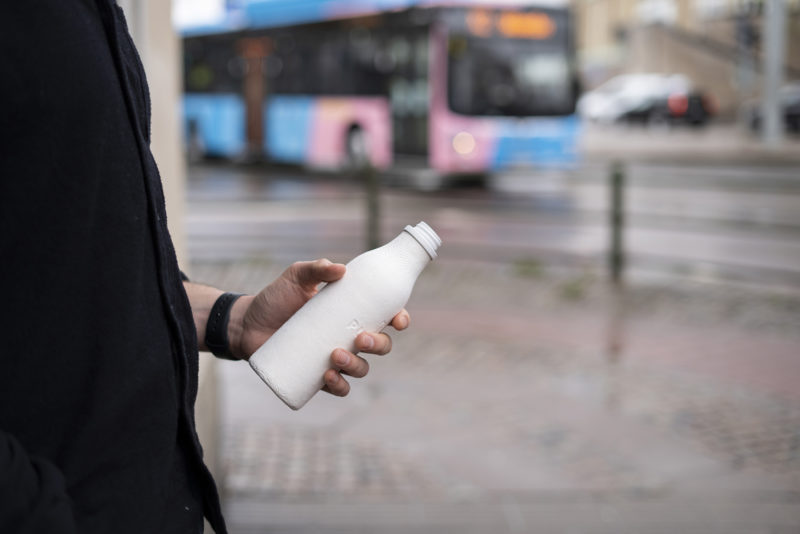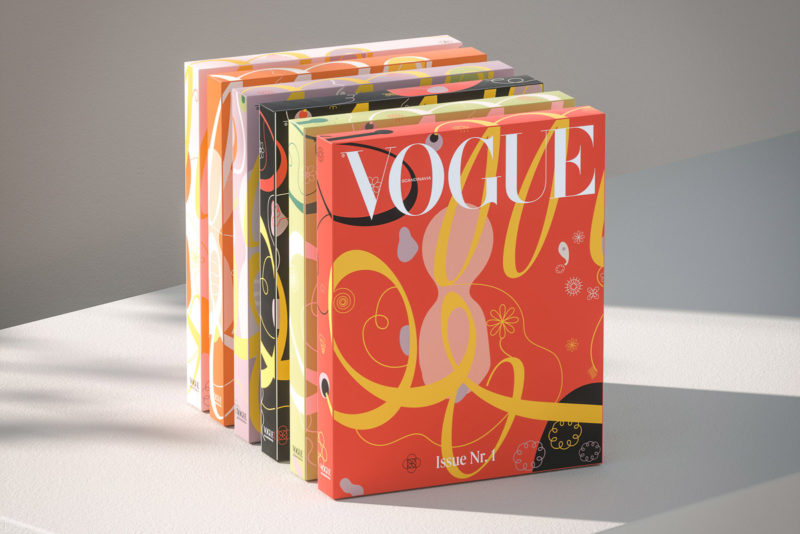Seven items made of wood that can reduce your carbon footprint on a daily basis

Wood-based materials can replace oil and other fossil raw materials in almost any branch of technology. We listed some environmentally friendly innovations from the forest industry that reduce waste and cut down on our daily carbon footprint.
1. Biodegradable wooden bottle
As early as 2022, many familiar beverages may be bought in a completely new bottle – one made of paper.
The bottle, made of form-pressed pulp, is introduced by Stora Enso and the packaging manufacturer Pulpex. The two companies say that the carbon footprint of their bottle is significantly smaller than with glass or plastic bottles. The paper bottle can be recycled as paper or paperboard, and it is biodegradable.

The paper bottle helps combat the continuous proliferation of plastic packagings. About 40 percent of all beverage packagings are made of plastics. In the European Union and the USA, only about 30–40 percent of all plastic bottles are recycled. This may be contrasted with the recycling rate of paper and paperboard, which is almost 80 percent.
’Our partnership is an important step in introducing a genuinely responsible alternative to plastic bottles and packagings. The properties of the new product are on a par with those of conventional beverage packagings,’ said Sohrab Kazemahvazi, SVP Formed Fiber at Stora Enso, on announcing the start of the industrial-scale manufacturing of wood fibre based bottles in May.
One of the collaborators behind the Pulpex company is Diageo, owner of such brands as Smirnoff and Guinness, and the Pulpex network of partners includes PepsiCo and Unilever, among others. Each of these companies is committed to introducing the Pulpex paper bottle in the packaging range of their beverages. The joint target is to produce a total of 750 million bottles a year.
2. Unbreakable toilet seat made of wood
The Finnish company Woodio, maker of design products of wood composite, has developed a wooden toilet seat. As far as is known, this is the first and only toilet seat made of a wood-based material that can be flushed with water.
The wood composite patented by Woodio combines wood chips and polymers. The material has a small carbon footprint, and it is one of Woodio’s stated aims to generate a low-emission alternative to bathroom ceramics.
Until now, Woodio has been best known for its wooden hand basin. It is made of birch chips, a sidestream of forest industry facilities, one of which is the Joutseno mill of Metsä Board, a part of the Metsä Group.

In the words of CEO Petro Lahtinen, the toilet seat brings the company’s use of wood composite to a completely new level.
‘Developing the toilet seat was clearly the most challenging development project during Woodio’s entire history. The design project took three years. We are now confident that we are able to make almost anything out of this material,’ Lahtinen says in the company’s media release.
In addition to eco-friendliness, the manufacturer lists other advantages which the wooden toilet seat has over conventional porcelain. The composite material is easy to clean and nice to sit on, but in addition, it is practically unbreakable. Woodio claims that the impact-resistant material could even be banged with a hammer without being dented.
3. Juice cartons with no plastics
A conventional beverage packaging made of paperboard, such as a juice carton, normally has a plastic coating which prevents leakages and the entry of air and foreign tastes into the carton.

The market, however, has a growing need for beverage packagings with no plastics. One of the companies developing these is Elopak, a producer of paper-based packaging solutions. Together with UPM and the chemicals company Dow, Elopak has developed a 100 % wood-based, renewable beverage packaging.
The innovation is based on a renewable wood-based plastic made of UPM’s renewable BioVerno diesel. BioVerno can be used in all chemical industry applications in the way of fossil diesel. The bio-based diesel is made of crude tall oil, which is a sidestream of pulp manufacturing.
4. Vogue Scandinavia in a renewable package
Announcing its new Nordic magazine called Vogue Scandinavia, the US publisher Condé Nast praised the role of the Nordic countries in developing more eco-friendly fashion.
Condé Nast wanted the sustainable Scandinavian thinking to be visible in the new magazine, so they also wanted to package it more ecologically. The first issue of the English-language Vogue Scandinavia comes out in August in a renewable, carbon-neutral package.
The packaging is part of the partnership between Vogue Scandinavia and Stora Enso. Vogue Scandinavia aims at complete carbon neutrality in packaging its magazines, by means of using renewable, low-carbon raw material and energy-efficient production.

’When I first made the decision to launch Vogue Scandinavia, I also made a commitment to change the publishing industry across the region and make our magazine a leader in sustainability,’ said Martina Bonnier, editor-in-chief of Vogue Scandinavia, on announcing the collaboration with Stora Enso.
Stora Enso will provide Vogue Scandinavia with expert services related to responsible materials and ’cradle to grave’ life cycle assessments. Stora Enso will also support Vogue Scandinavia in transparent sustainability reporting.
5. Kuura textile fibre is designed for world markets
The annual global production of textile fibres exceeds a hundred million metric tons. There is a huge demand for sustainably produced fibres, and one of the possible answers is wood pulp.
The innovation company Metsä Spring, part of the Metsä Group, has developed a textile fibre named Kuura (meaning rime or hoarfrost). The material was introduced to the public in March at a Japanese fashion event, in partnership with the fashion brand The Reracs.
The Kuura textile fibre is manufactured at the Äänekoski bioproduct mill, in a pilot facility owned jointly by Metsä Spring and the Japanese trading company Itochu.
’Our joint project is now at a stage where we can focus more strongly on exploring the market potential of the fibre and determine its suitability for various purposes,’ said Niklas von Weymarn, CEO of Metsä Spring earlier this year.

The Kuura fibre is manufactured from undried pulp, using chemicals which are safer and more eco-friendly than those used before. The raw material supply is guaranteed by the adjacent bioproduct mill. It also provides completely non-fossil energy and enables the sensible use of water and other resources.
’The Kuura textile fibre is an excellent example of the more advanced pulp-based products made possible by our bioproduct mill concept,’ says von Weymarn.
6. Bio-based adhesive for healthier indoor air
Lignin is the second most common natural macromolecule (after cellulose), and it is becoming an increasingly common raw material of industrial products.
One of the latest innovations based on lignin is a bio-based binder by Stora Enso. The NeoLigno binder is a fully non-toxic alternative to fossil-based binders and hazardous chemicals. It contains no formaldehyde or isocyanate, which are common ingredients in other binders.
NeoLigno is made of lignin which Stora Enso has produced commercially since 2015 at its Sunila facility in Kotka, southern Finland. The new binder can be used to manufacture chipboards and insulation materials, among other things.
’We are doing pioneering work by bringing to the market natural binders which promote healthier living,’ says Lauri Lehtonen, Head of Innovation of Stora Enso’s Biomaterials division.z

7. Lighter car tyres thanks to wood
UMP Biochemicals is manufacturing a new type of filler to respond to the demands of the automotive industry for more ecological materials. The RFF (Renewable Functional Filler) is made of lignin and can replace fossil materials used in the automotive industry.
In the long run, UPM Biochemicals believes that the lignin used in the filler will become a mainstream material in several branches of industry, since it is a completely bio-based alternative to fossil materials.
According to Nokian Tyres, for example, one third of the rubber mixture used in making tyres consists of filler. It also contains soot, which makes the tyres black. Oil is generally used as plasticiser. In addition, various chemicals and protective and vulcanizing agents are needed.
The wood-based filler by UPM replaces carbon black and substances like silica. It reduces the toxicity of the rubber mixture and makes it electrically non-conductive, as well as reducing the carbon footprint of tyres.
According to UPM, the bulk density of the RFF fillers is at least 25–30 percent less than that of fossil alternatives. One of their great advantages is that they are light in weight, which will help the automotive industry to offset the weight of batteries in electric cars.